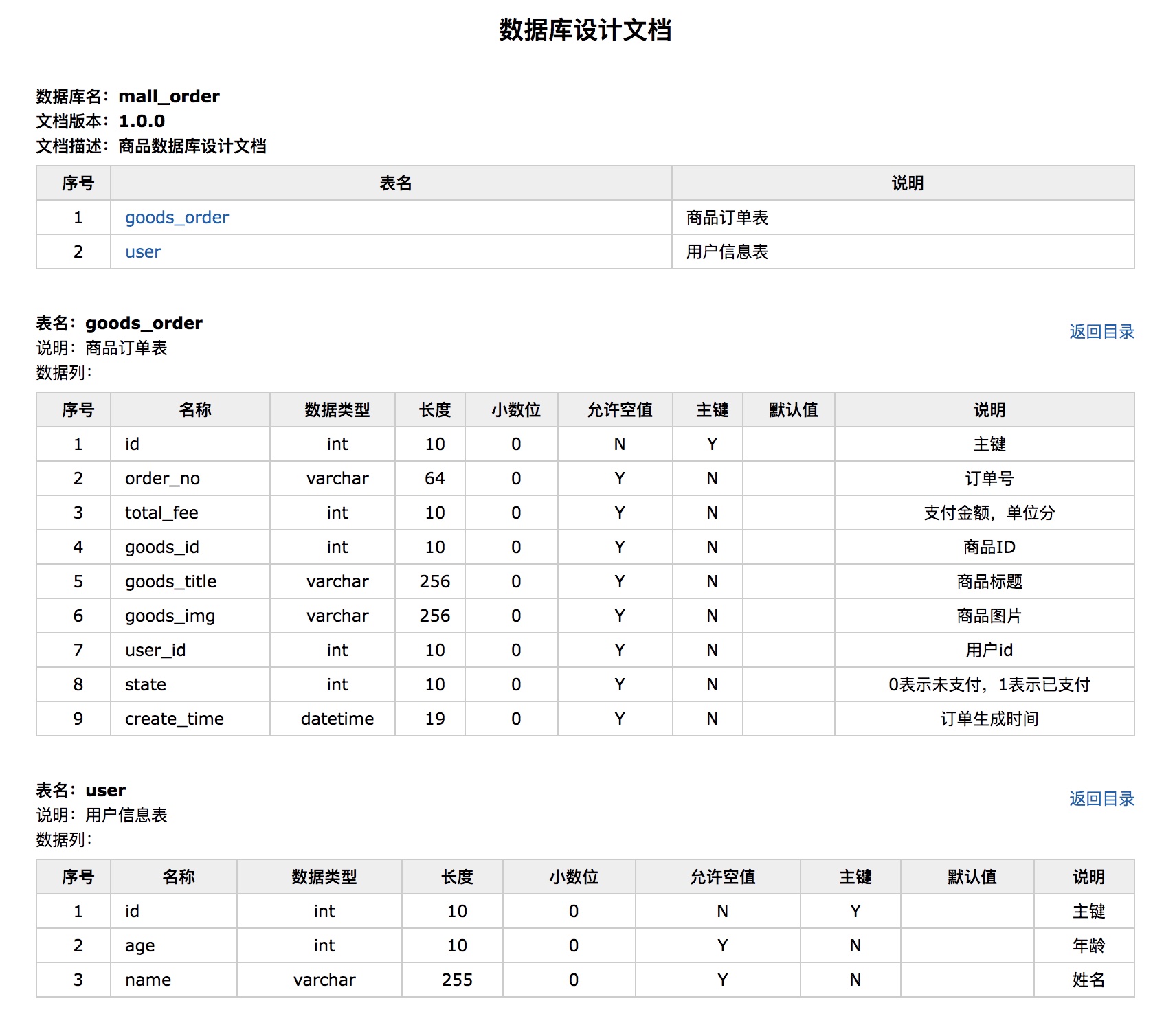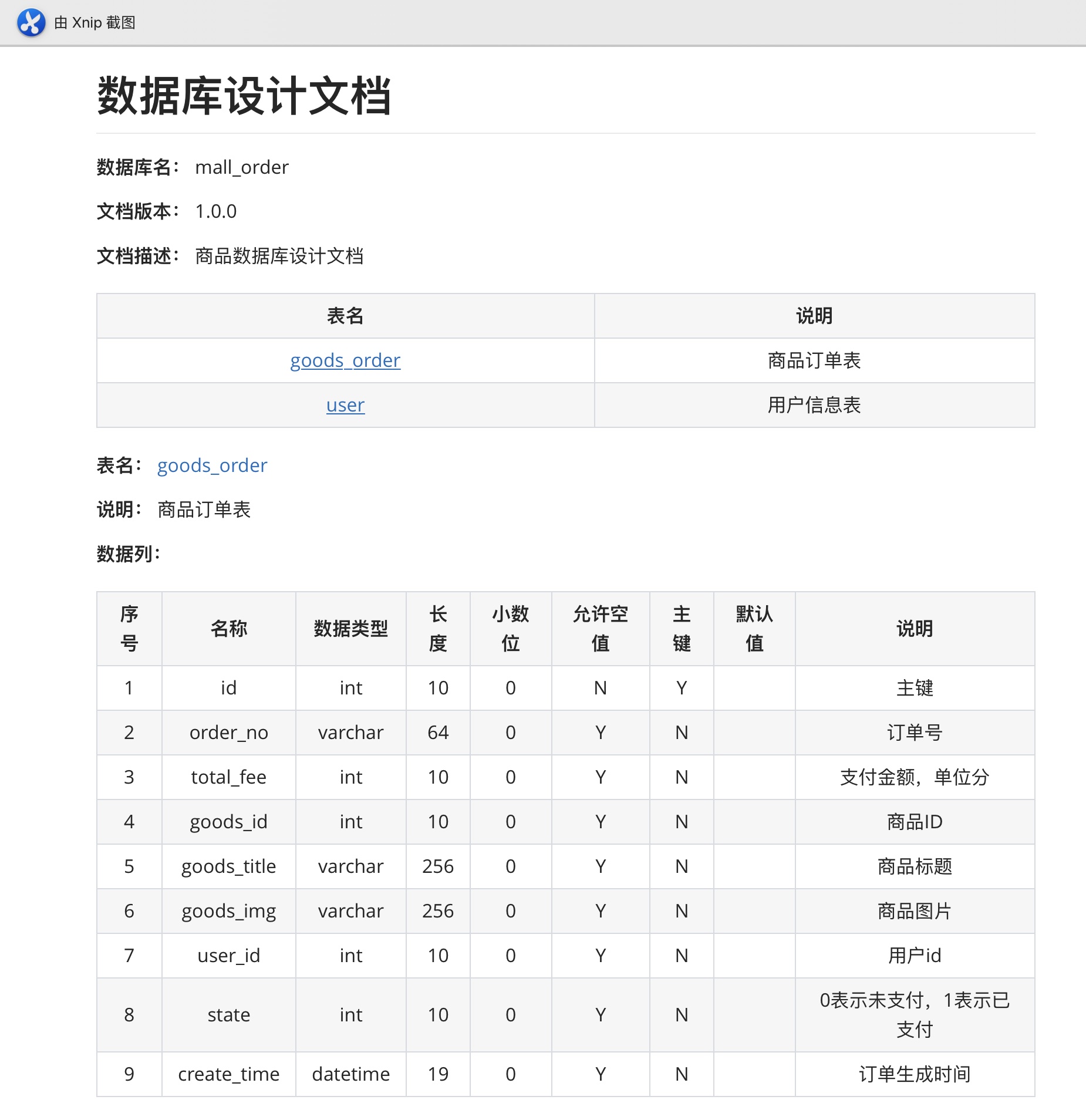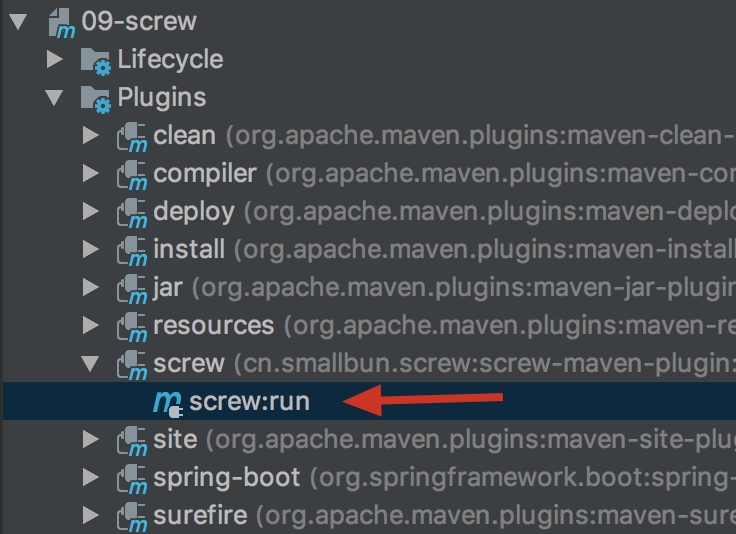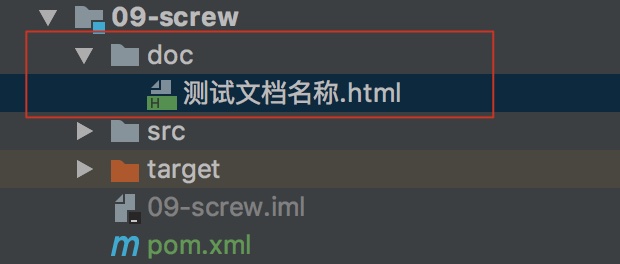对于开发的API文档,我们可以通过Swagger等工具来自动生成了。但是对于数据库表结构的文档呢,在实际开发中在开发前我们一般会先设计好表结构,大家讨论一下, 这个时候就很需要
对于开发的API文档,我们可以通过Swagger等工具来自动生成了。但是对于数据库表结构的文档呢,在实际开发中在开发前我们一般会先设计好表结构,大家讨论一下,
这个时候就很需要有个数据库表结构的文档,如果常规操作就是一通无脑的 CV 大法,产出一份小几十页的 Word 文档,这样不仅容易出错,而且如果表结构变了还需修改
Word文档,非常不方便。
这里介绍并演示一个开源的 生成数据库表结构的文档 的工具,可以帮我们高效的自动 生成数据库表结构文档。
工具名称: screw。
开源地址: https://gitee.com/leshalv/screw。
有兴趣的朋友可以研究下源码,没兴趣就直接拿来用就好了。
一、 screw 简介
screw 是一个简洁好用的数据库表结构文档的生成工具 ,支持 MySQL、Oracle、PostgreSQL 等主流的关系数据库。
生成的文档有 HTML、Word、Markdown 三种格式 ,示例如下图所示:
1、Html演示效果 2、Word演示效果
2、Word演示效果
 3、Markdown演示效果
3、Markdown演示效果

看完演示效果,我们接下来看看如果生成 数据库文档,其实非常简单,我们下面示范下。
二、快速入门
screw 有两种方式 来生成文档,通过 Java代码 或者 Maven插件 。
下面,我们来分别快速入门下。
1、使用 Java 代码的方式1、引入pom文件
<dependencies>
<dependency>
<groupId>cn.smallbun.screw</groupId>
<artifactId>screw-core</artifactId>
<version>1.0.5</version>
</dependency>
<!-- 数据库连接 -->
<dependency>
<groupId>com.zaxxer</groupId>
<artifactId>HikariCP</artifactId>
<version>3.4.5</version>
</dependency>
<dependency>
<groupId>mysql</groupId>
<artifactId>mysql-connector-java</artifactId>
<version>8.0.22</version>
</dependency>
</dependencies>
2、实现工具类
public class ScrewUtil {
public static void main(String[] args) {
ScrewUtil.documentGeneration();
}
/**
* 文档生成
*/
static void documentGeneration() {
//数据源
HikariConfig hikariConfig = new HikariConfig();
hikariConfig.setDriverClassName("com.mysql.cj.jdbc.Driver");
hikariConfig.setJdbcUrl("jdbc:mysql://localhost:3306/mall_order");
hikariConfig.setUsername("root");
hikariConfig.setPassword("root");
//设置可以获取tables remarks信息
hikariConfig.addDataSourceProperty("useInformationSchema", "true");
hikariConfig.setMinimumIdle(2);
hikariConfig.setMaximumPoolSize(5);
DataSource dataSource = new HikariDataSource(hikariConfig);
//生成配置
EngineConfig engineConfig = EngineConfig.builder()
//生成文件路径
.fileOutputDir("你的生成文件地址")
//打开目录
.openOutputDir(true)
//文件类型
.fileType(EngineFileType.HTML)
//生成模板实现
.produceType(EngineTemplateType.freemarker)
//自定义文件名称
.fileName("商品数据库表结构").build();
//忽略表
ArrayList<String> ignoreTableName = new ArrayList<>();
ignoreTableName.add("test_user");
ignoreTableName.add("test_group");
//忽略表前缀
ArrayList<String> ignorePrefix = new ArrayList<>();
ignorePrefix.add("test_");
//忽略表后缀
ArrayList<String> ignoreSuffix = new ArrayList<>();
ignoreSuffix.add("_test");
ProcessConfig processConfig = ProcessConfig.builder()
//指定生成逻辑、当存在指定表、指定表前缀、指定表后缀时,将生成指定表,其余表不生成、并跳过忽略表配置
//根据名称指定表生成
.designatedTableName(new ArrayList<>())
//根据表前缀生成
.designatedTablePrefix(new ArrayList<>())
//根据表后缀生成
.designatedTableSuffix(new ArrayList<>())
//忽略表名
.ignoreTableName(ignoreTableName)
//忽略表前缀
.ignoreTablePrefix(ignorePrefix)
//忽略表后缀
.ignoreTableSuffix(ignoreSuffix).build();
//配置
Configuration config = Configuration.builder()
//版本
.version("1.0.0")
//描述
.description("商品数据库设计文档")
//数据源
.dataSource(dataSource)
//生成配置
.engineConfig(engineConfig)
//生成配置
.produceConfig(processConfig)
.build();
//执行生成
new DocumentationExecute(config).execute();
}
}
pom文件添加插件
<build>
<plugins>
<plugin>
<groupId>cn.smallbun.screw</groupId>
<artifactId>screw-maven-plugin</artifactId>
<version>${lastVersion}</version>
<dependencies>
<!-- HikariCP -->
<dependency>
<groupId>com.zaxxer</groupId>
<artifactId>HikariCP</artifactId>
<version>3.4.5</version>
</dependency>
<!--mysql driver-->
<dependency>
<groupId>mysql</groupId>
<artifactId>mysql-connector-java</artifactId>
<version>8.0.20</version>
</dependency>
</dependencies>
<configuration>
<!--username-->
<username>root</username>
<!--password-->
<password>password</password>
<!--driver-->
<driverClassName>com.mysql.cj.jdbc.Driver</driverClassName>
<!--jdbc url-->
<jdbcUrl>jdbc:mysql://127.0.0.1:3306/xxxx</jdbcUrl>
<!--生成文件类型-->
<fileType>HTML</fileType>
<!--打开文件输出目录-->
<openOutputDir>false</openOutputDir>
<!--生成模板-->
<produceType>freemarker</produceType>
<!--文档名称 为空时:将采用[数据库名称-描述-版本号]作为文档名称-->
<fileName>测试文档名称</fileName>
<!--描述-->
<description>数据库文档生成</description>
<!--版本-->
<version>${project.version}</version>
<!--标题-->
<title>数据库文档</title>
</configuration>
<executions>
<execution>
<phase>compile</phase>
<goals>
<goal>run</goal>
</goals>
</execution>
</executions>
</plugin>
</plugins>
</build>
运行插件

运行成功后,我们看到在当前项目中已经存在了,数据库文档。

补充
有关screw工具的补充,可以查看源码: https://gitee.com/leshalv/screw。
自己也把该篇文章的演示代码放到了github上,具体地址: https://github.com/yudiandemingzi/spring-boot-study

